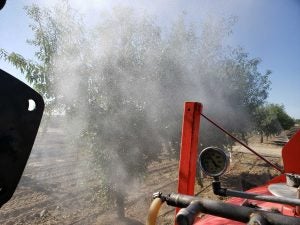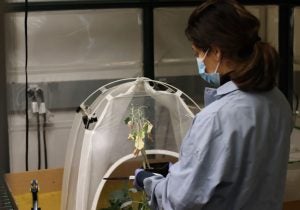As with so much else in nature, crop pests — including insects, fungi, and diseases — are not static. They are ever-changing and evolving, forcing agriculturalists to come up with new ways to combat and respond to them.
One of the beautiful things about modern-day agriculture is the many ways farmers can diversify their arsenals to better combat these pests to best fit the needs and situation of their particular farm. Among these tools are biological pesticides (or biopesticides).
This category encompasses many individual products — in fact, the U.S. Environmental Protection Agency had nearly 300 approved active ingredients for biopesticides and over 1,401 biopesticide products registered as of 2016.
While there are diverse options for organic growers (who often turn to this list because of National Organic Program limitations on synthetic products), biopesticides, in general, tend to have varying degrees of success. When it comes to mainstream conventional ag, there are several inhibitors making them less than practical for typical growers.
That said, as multiple companies put more research and product development into these types of products, the potential for biopesticides to becomes more accessible and useful to conventional producers increases. This could be a big win for producers as a whole — ultimately, because more diverse products can help cut down on pest resistance while providing a broader range of protection.

A tool with some considerations
Biopesticides are required to be made from ingredients that are usually live microorganisms. While certain ingredients in this category have their perks — such as generally having lower toxicity for handling and application — they also have some pretty unfortunate shortcomings.
“Depending on the product and target organism, in general more product needs to be applied with a biological for toxicity,” says Dominic Reisig, professor and extension specialist at North Carolina State University. “Sometimes they can require special storage conditions, like cool temperatures or darkness, and often have a lower shelf life.”
They also tend to be very specific, which Reisig notes can be a pro as this means they will only kill the target organism. But in a very narrow environment, this is a drawback worth considering.
Crop Enhancement is one company working to help fill in some of those gaps that could make biopesticides more accessible to more farmers.
Their latest product, CropCoat, is applied via spray which coats the leaves and binds to the plant’s surface. This creates a hard layer of film making it uninhabitable to insects that doesn’t leave behind a chalky appearance some other products might — and the film is entirely biodegradable.
Nastaran Tofangsazi is an entomologist who has been evaluating CropCoat for effectiveness in the laboratory. She says that residual life is among the concerns of many biopesticides, which often have a residual life that lasts only hours to days.
“CropCoat provides significantly longer residual control,” she says, “and its efficacy is comparable to conventional insecticides.”
Other companies are also delving deeper into the biological realm. In March 2021, Meristem Crop Performance Group and Planet Earth Agronomy announced a partnership for new strategic product development specifically with biologicals.
“Farmers need real-life solutions that work under the stress of efficient, intensive crop production,” said Larry Fiene, CEO of Planet Earth in a news release. “We’re finding new methods of making biologicals and synthetics work together, be effective in the spray tank or on dry fertilizer and provide a better ROI [return on investment] for growers.”
In a similar way, BASF and AgBiome also announced a collaborative to create a new biological fungicide to be introduced to the European, Middle Eastern, and African markets. According to their news release, the new product utilizes the bacterium Pseudomonas chlororaphis and can be applied on a variety of ornamentals, turf, and vegetables. Its creators are optimistic it will be able “to complement conventional crop protection products as part of a comprehensive integrated pest management program.”

Finding opportunity with technology
Currently, biopesticides have a relatively small place in mainstream crop protection, Reisig says, noting he does expect that to change in the not-too-distant future.
“Pests are always in an ‘arms race’ with their hosts,” he explains. “As pests overcome the host, the host evolves mechanisms to defend itself. So, there are a lot of compounds and organisms sitting in the environment now that are not yet explored, some of which are very effective.”
Likewise, he says that genetic engineering efforts may also produce some biological hybrids that could be used for crop protection.
Solutions like CropCoat may very well soon be a part of that. Tofangsazi says she believes it can be great used in rotation to help eliminate pest resistance for conventional producers.
“CropCoat is a nontoxic insecticide, and conventional growers that produce crops for export might not have issues with exceeding pesticide residue levels,” she says. “Organic growers can benefit from consistent high efficacy and less frequent insecticide applications and the cost associated with it.”
After several years of development, this project just launched commercially for cocoa growers in Indonesia. However, being a broad-spectrum insecticide, Tofangsazi says it can be used for a variety of crops.
“For example, we find that in almonds, we’re able to reduce damage caused navel orangeworm to levels approaching that achieved by conventional pesticides,” she says.
If regulatory approval is on track, CropCoat could launch in U.S. soil in time for the 2023 growing season. BASF and AgBiome say they hope to launch their fungicide in select countries by 2024 or 2025.
Jaclyn Krymowski is a recent graduate of The Ohio State University with a major in animal industries and minor in agriculture communications. She is an enthusiastic “agvocate,” professional freelance writer, and blogs at the-herdbook.com.



